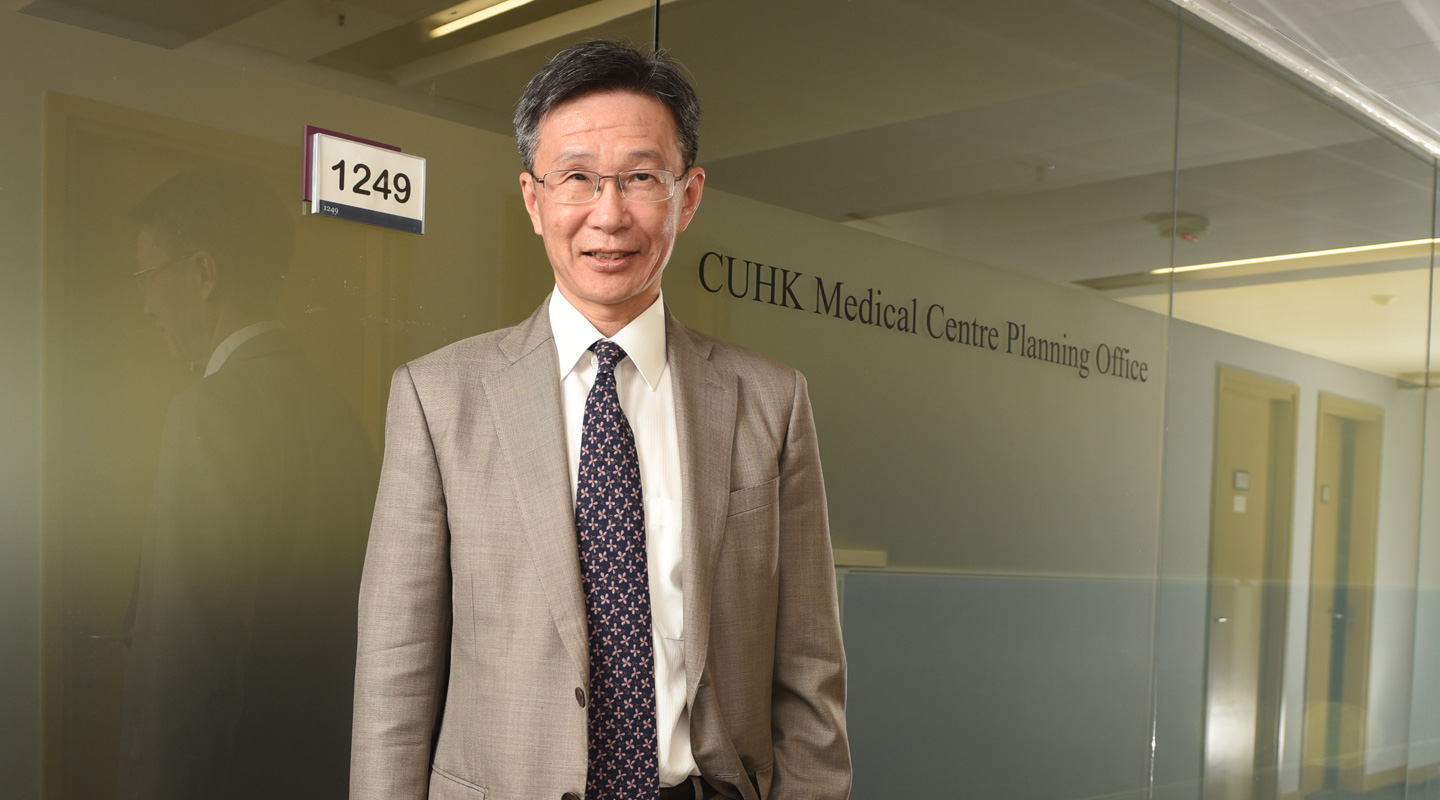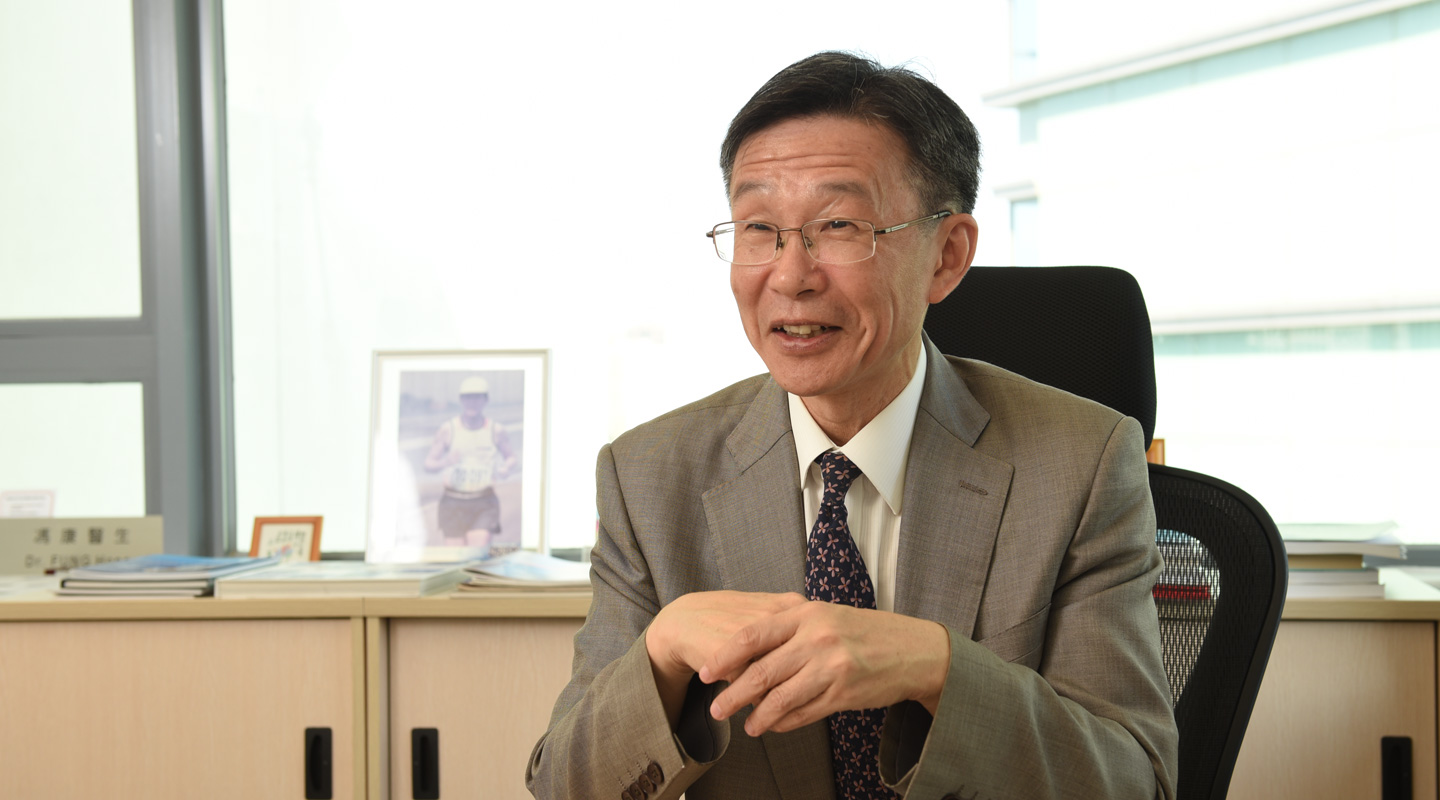Dear readers, With the launch of e-newsletter CUHK in Focus, CUHKUPDates has retired and this site will no longer be updated. To stay abreast of the University’s latest news, please go to https://focus.cuhk.edu.hk. Thank you.
Dr. Fung Hong's Prescription for the Health System

Dr. Fung Hong
-
Executive Director and Chief Executive Officer of CUHK Medical Centre
-
Honorary Professor of Jockey Club School of Public Health and Primary Care, CUHK
-
Director of CUHK Medical Centre Planning Office
Can you please tell us about the progress of the CUHK Medical Centre (CUHKMC)?
Construction work has been progressing well. All piling works for the building structure and retaining walls have been completed. Pile loading tests and pile capping are underway. After foundation work is completed, work will begin for the upper floors. Building runs in parallel with design. The contractors, architects and engineers work together to hammer out the details at every stage of construction. When completed, there will be 14 floors with around 2,500 rooms in the CUHKMC catering to the many different functions and facilities in a modern hospital—operating theatres, maternity rooms, patient wards, a day surgery centre, chemo and radiotherapy clinics and an integrated outpatient clinic, etc.—all equipped and fitted out to their specialized requirements.
Please explain the concept of a non-profit private hospital.
Broadly speaking, a non-profit private hospital occupies the niche between a public hospital, characterized by low cost and extreme long queues, and a private one which charges fees at the going market rates. Such a hospital provides services to the middle-income classes at very affordable rates, hoping that it will help ease the burden on public hospitals.
On a down-to-earth level, it is truly patient-based and a model that provides a one-stop answer to the patients’ dilemmas. You don’t need to solicit doctors’ referrals to get admitted. You can be assured that the medical procedure recommended or performed is not motivated by profit. You don’t have to be over-scrupulous with the hospital bills. The CUHKMC will inspire confidence in the public, that any recommended treatment or service will only be put forward with the patients’ well-being in mind. Further, it will help raise the patients’ awareness to live healthy, even though treating patients is its main source of income.
What made you take up the challenges of CUHKMC’s first executive director?
From a medical student to a practitioner, I have always wanted to find ways to better medical services by reforming the system. It is because I believe that devising a good system will exponentially multiply the benefits to the patients. I started out as a surgeon. In 1989 I joined the then Hospital Services Department. Soon after I joined the newly established Hospital Authority responsible for the development of medical services and hospital planning. My job included choosing districts for new hospitals and building clinical information systems. In 2002, I was appointed director of the New Territories East Cluster and executive director of the Prince of Wales Hospital (PWH). I made the switch because I wanted to enhance the services of the public hospital system with institutional and systemic changes. Another decade passed and I came to another point where another problem and another opportunity were presented me. The CUHKMC project gives me the chance to continue on this journey of exploring a new model to perfect the healthcare system.
How do you understand what the public need medically?
Public health studies rely very much on demographic and socio-economic data. But I have learned that paying attention to what the patients said is more important. A medical professor may know everything about a sickness but not necessarily what problems the sick faces. We’re beginning to collect patients’ stories systematically. Prof. Justin Wu and I are targeting mainly CUHK alumni as our interview subjects in the hope to retrace what they had gone through in finding a cure. We hope to analyse and deduce from their stories the systemic problems in order to reach a new thinking of how to deliver our services.
How would CUHKMC, once launched, complement the teaching and research of CUHK’s Faculty of Medicine and the training of medical professionals in Hong Kong?
PWH’s role as a teaching and research hub is irreplaceable, as much fundamental research is still to be carried out in the public system. But as far as translational medicine, that is, how to translate research findings into practical use, is concerned, a private hospital has much room to manoeuvre. To some extent we can build a new platform of teaching and research in parallel with PWH’s. Our innovative edges lie in some promising areas of research and applications that make use of, for example, big data or even AI. Our priorities are of course to complement and support the training in the Faculty of Medicine, the School of Chinese Medicine, the Nursing School and the School of Pharmacy.

Amidst such a hectic schedule, how do you unwind?
When people talk about work-life balance, work and life are treated like two different things that counteract and cancel each other out. If I’m perfectly composed and poised, balance is not a problem. When I start running, I’d inevitably think of how to run better and faster. Instead of relaxing, I’d in fact be piling more pressure on myself. That defeats the purpose, doesn’t it? Pressure doesn’t come with activity. It comes with one’s attitude. That’s why I always told my colleagues: if one finds value and meaning in one’s work, and treat it with passion like it’s part of one’s life, there’s no pressure in doing it. For example, I wouldn’t be telling the truth if I say there’s no pressure in my picking up erhu again after dropping it for 30 years to make time for my career. Now that I have the chance to start over, I have joined two orchestras. With every performance there is undoubtedly pressure, but also immense joy.
This article was originally published in No. 508, Newsletter in Dec 2017.